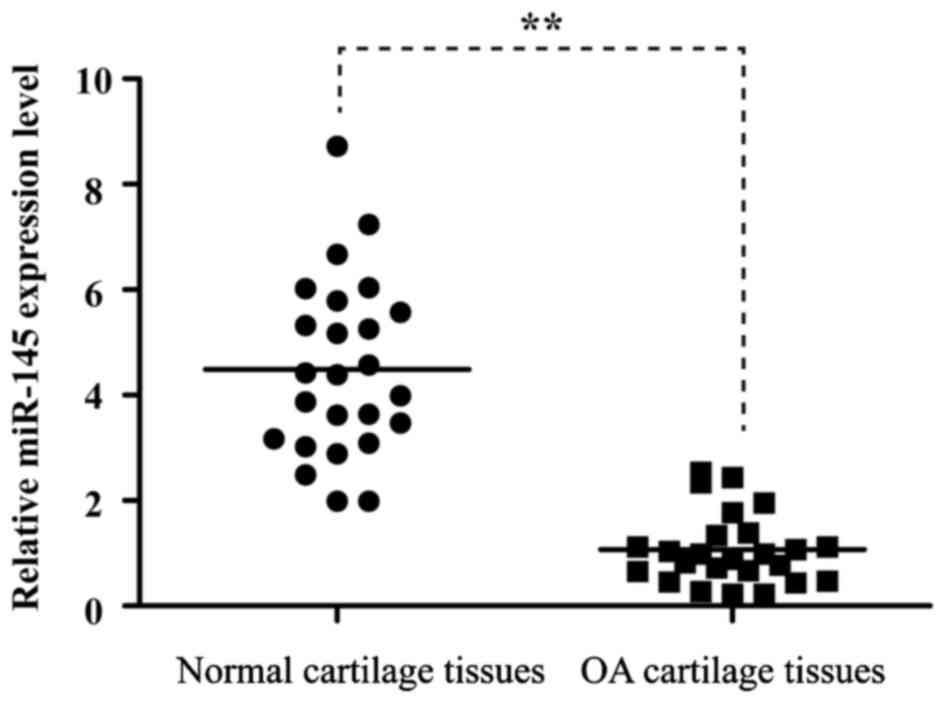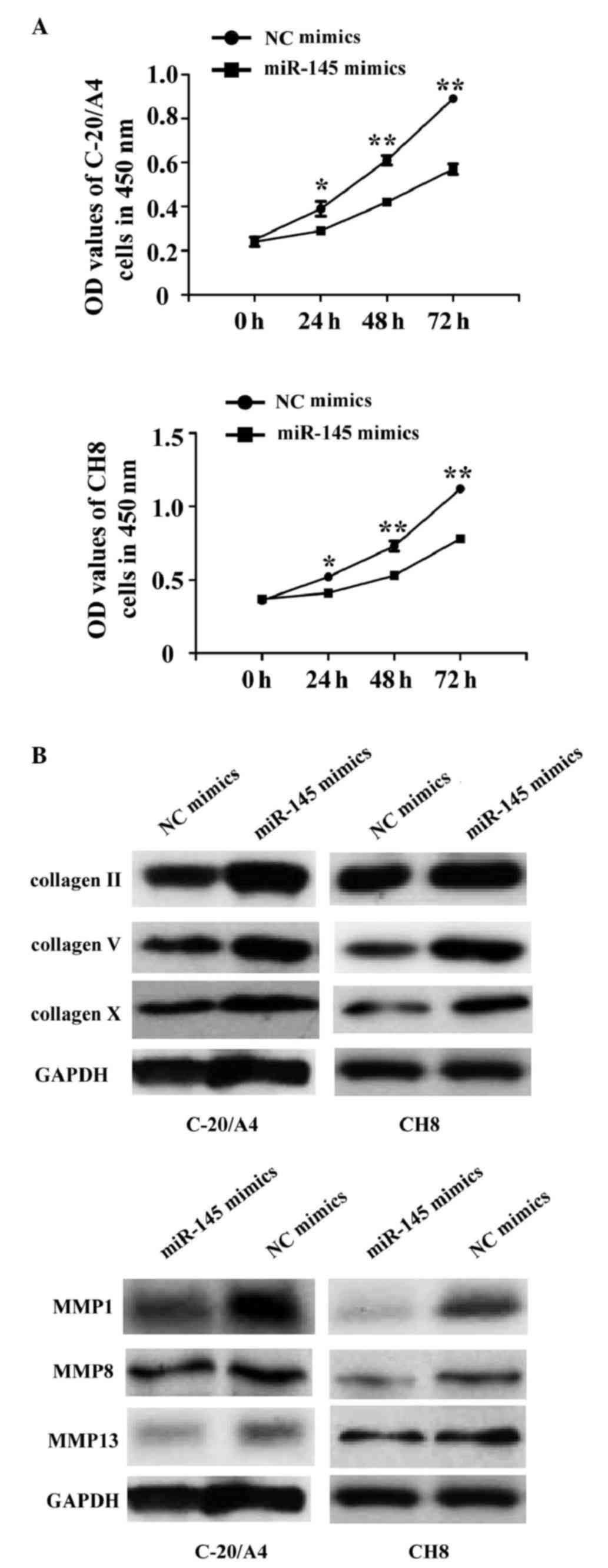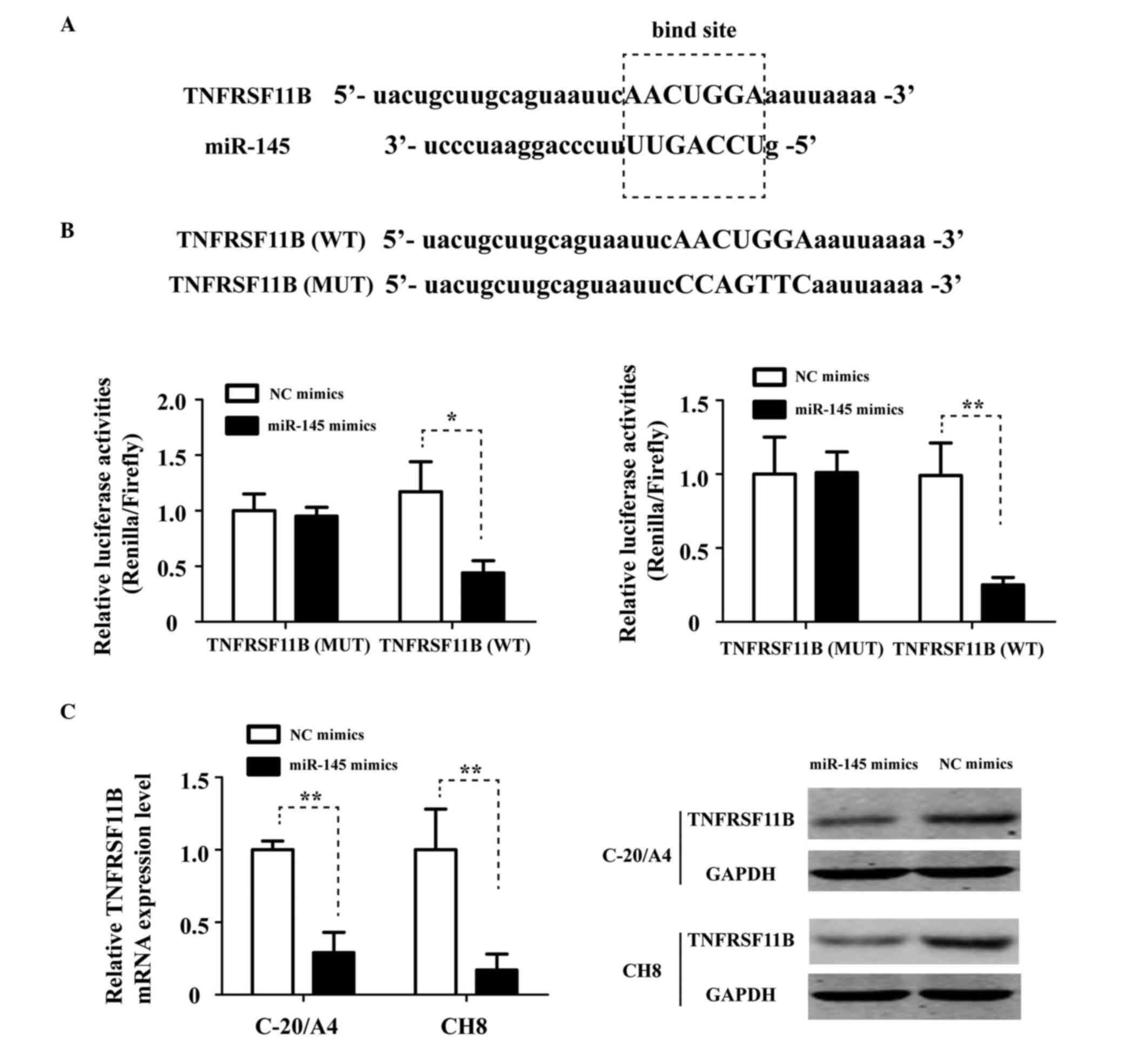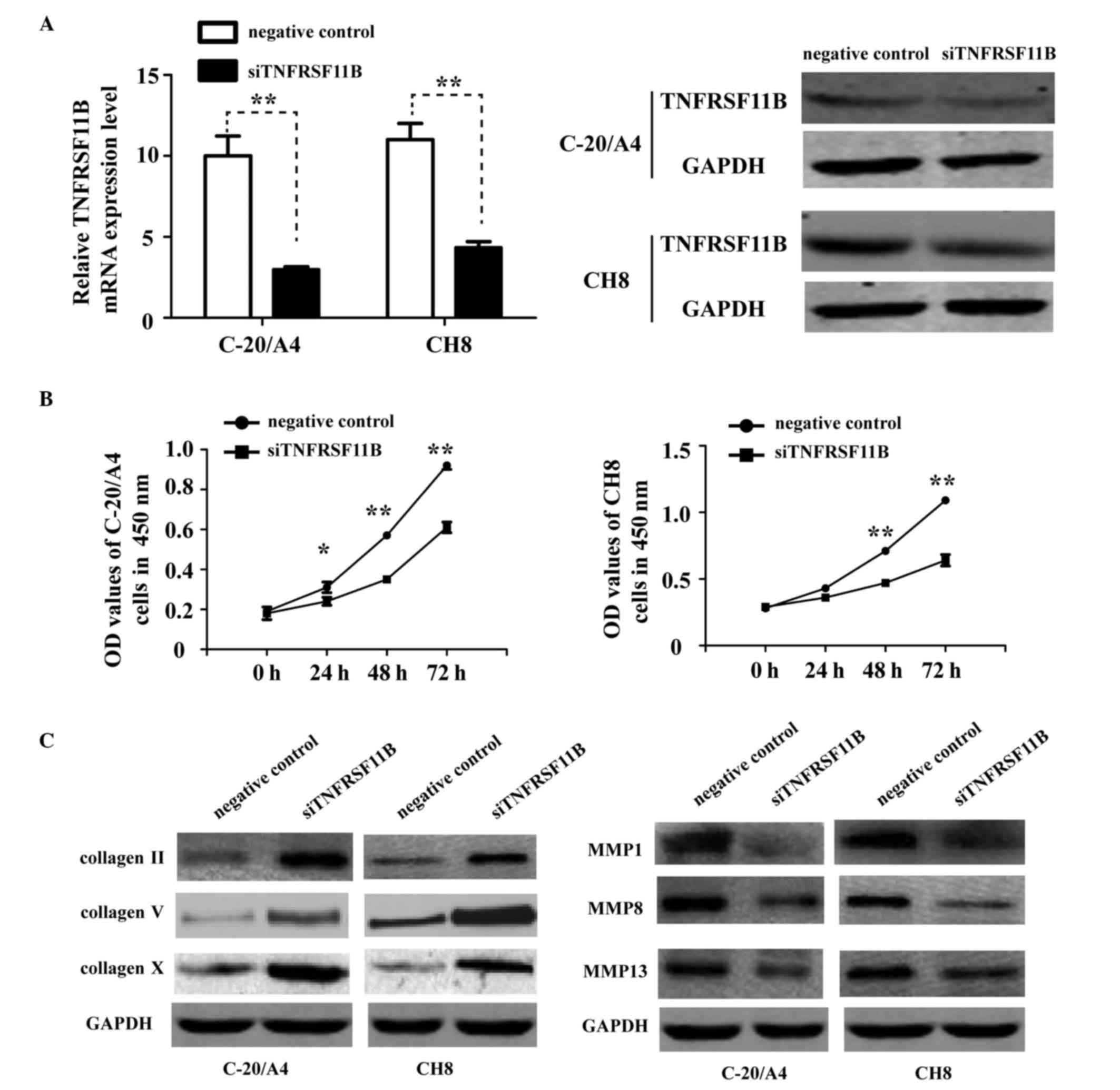Effects of miR-145 on the inhibition of chondrocyte proliferation and fibrosis by targeting TNFRSF11B in human osteoarthritis
- Authors:
- Published online on: December 5, 2016 https://doi.org/10.3892/mmr.2016.5981
- Pages: 75-80
Abstract
Introduction
Osteoarthritis (OA) is the most common form of musculoskeletal disease (1). It is a complex and multifaceted disease, which is predominantly characterized by the degradation of articular cartilage and joint inflammation (2). Chondrocytes in the articular cartilage regulate appropriate gene expression in order to achieve tissue homeostasis. At present, although a number of pathways underlying the pathogenesis of OA have been demonstrated, it remains to be fully elucidated and current knowledge has not provided effective approaches for prevention or treatment.
MicroRNAs (miRNAs) are small non-coding RNAs, which have been reported to be important regulators of gene expression in humans and function as negative regulator of gene expression at the post-transcriptional level via binding to complimentary sequences in the 3′-untranslated regions (3′-UTRs) of targeting mRNAs (3,4). Hundreds of miRNAs have been found in various organisms, and a third of all mammalian mRNAs appear to be under the regulation of miRNAs (5). Aberrant miRNA expression profiles have been demonstrated to be associated with the development of OA, and their functions are beginning to be delineated (6–8).
miR-145 has been indicated to be important in tumor progression and metastasis, specifically in the processes of cell proliferation and differentiation (9–11). However, the role of miR-145 in the progression of OA and its underlying mechanism remains to be fully elucidated. The present study aimed to demonstrate the biological function and molecular mechanism of miR-145 in OA. The expression of miR-145 was found to decrease and that of tumor necrosis factor receptor superfamily, member 11b (TNFRSF11B) was found to increase in OA cartilage tissues, compared with normal cartilage tissues. It was also revealed that miR-145 was important in chondrocyte proliferation and fibrosis by directly targeting TNFRSF11B, which inhibited the proliferation and fibrosis of OA.
Materials and methods
Cell lines and patient samples
The C-20/A4 and CH8 human articular chondrocytes cell lines were obtained from American Type Culture Collection (Manassas, VA, USA). All cells were cultured in Dulbecco's modified Eagle's medium supplemented with 10% fetal bovine serum in a humidified atmosphere of 5% CO2 at 37°C. A total of 25 paired cartilage tissues, and matched normal cartilage tissues from traumatic amputees were obtained from the knees of patients with OA. Each patient provided consent for the experiment, and the present study was approved by the Ethics Committee of the Affiliated Hospital of Jining Medical University (Jining, China).
RNA extraction and reverse transcription-quantitative polymerase chain reaction (RT-qPCR) analysis
Total RNA from the tissues and cells were extracted using TRIzol reagent (Invitrogen; Thermo Fisher Scientific, Inc., Waltham, MA, USA) and purified using the RNeasy Maxi kit (Qiagen GmbH, Hilden, Germany) according to the manufacturer's protocol. The miScript reverse transcription kit (Qiagen GmbH) and RevertAid First Strand cDNA Synthesis kit (Qiagen GmbH) were used to obtain the total cDNA. The miScript SYBR Green PCR kit (Qiagen GmbH) and SYBR® Premix Ex Taq™ II (Takara Bio, Inc., Otsu, Japan) were used for the qPCR assay. The PCR reaction mixture contained: 1 µl cDNA, 2 µl specific primer, 2 µl 10X miScript SYBR Green PCR Master Mix (or SYBR® Premix Ex Taq™ II) and 5 µl RNase-free water. The amplification conditions were as follows: 95°C for 10 min, followed by 45 cycles at 95°C for 30 sec, 60°C for 30 sec and 72°C for 30 sec, and a final extension step at 72°C for 5 min. Human U6 and GAPDH were used as the internal control genes. The miR-145- and U6-specific primers were as follows: miR-145 forward 5′-GAATCCCTTAGATGCTAAGATG-3′ and reverse (miScript SYBR Green PCR kit universal primer); U6, forward 5′-CTCGCTTCGGCAGCACA-3′ and reverse 5′-ACGCTTCACGAATTTGCGT-3′. The TNFRSF11B- and GAPDH-specific primers were as follows: TNFRSF11B, forward 5′-CCCCTTGCCCTGACCACTACTA-3′ and reverse 5′-CGATTGCACTCCTGCTTGACGT-3′; GAPDH, forward 5′-ACATCAAGAAGGTGGTGAAGCAGG-3′ and reverse 5′-AGCGTCAAAGGTGGAGGAGTGG-3′. The relative expression level was determined using the delta-delta Cq method (12).
Cell transfection
The miR-145 mimics, negative control (NC) mimics, small interfering (si)TNFRSF11B and negative control were designed and synthesized by Invitrogen Life Technologies; Thermo Fisher Scientific, Inc. The sequence of the miR-145 mimic was 5′-GUCCAGUUUUCCCAGGAAUCCCU-3′ and that of the NC mimic was 5′-UUCUCCGAACGUGUCACGUUU-3′. The sequence of siTNFRSF11B was 5′-CAGGCACUUGAGGCUUUCAGUGAUA-3′ and that of the NC was 5′-CAGUACUUUUGUGUAGUACAA-3′. Cell transfection was performed using Lipofectamine 2000 (Invitrogen; Thermo Fisher Scientific, Inc.), according to the manufacturer's protocols.
In vitro cell proliferation assay
Cell proliferation was measured using a 3-(4,5-dimethylth-iazol-2-yl)-2,5-diphenyltetrazolium bromide (MTT) assay. The C-20/A4 and CH8 cells (~4×103) were seeded into a 96-well plate and transfected with the miR-145 or NC mimics, and siTNFRSF11B or the NC at 37°C. At 0, 24, 48 or 72 h-post transfection, 25 µl of MTT reagent (5 mg/ml; Sigma-Aldrich; Merck Millipore, Darmstadt, Germany) was added to each plate and incubated at 37°C for 4 h. Subsequently, the MTT medium mixture was discarded and 150 µl of dimethyl sulfoxide was added to each plate and agitated for 30 min at 37°C to solubilize the crystals. Absorbance was measured at a wavelength of 450 nm using an ELISA microplate reader (Bio-Rad Laboratories, Inc., CA, USA).
Dual-luciferase reporter assay
In order to confirm whether miR-145 was able to directly bind the 3′-UTR of the TNFRSF11B gene, the miR-145 target sequences of TNFRSF11B were inserted between the Xhol and NotI restriction sites of the 3′-UTR of the hRluc gene in the psiCHeCK™-2 luciferase vector (Promega Corporation, Madison, WI, USA). Primer sequences for the 3′-UTR of TNFRSF11B mRNA were designed by Thermo Fisher Scientific, Inc., as follows: Forward 5′-CTCGCTTCGGCAGCACA-3′ and reverse 5′-ACGCTTCACGAATTTGCGT-3′. The recombination plasmid of psiCHECK-2-TNFRSF11B-3′-UTR was constructed, which contained the potential binding sites, and the potential binding sites were manually mutated by exchanging the G and T, A and C. Subsequently, the luciferase recombination reporter constructs, together with the miR-145 mimics or NC mimics, were cotransfected into the C-20/A4 and CH8 cells at 37°C. The Firefly and Renilla luciferase activities were detected using a dual luciferase assay system (Promega Corporation), according to the manufacturer's protocol, 24 h following transfection. Normalized data were calculated as the quotient of Renilla/Firefly luciferase activities.
Western blot analysis
Total proteins of the chondrocyte tissues and cells were extracted using RIPA buffer (Invitrogen; Thermo Fisher Scientific, Inc.) supplemented with protease inhibitor cocktail (EMD Millipore, Billerica, MA, USA). Protein concentration was determined using the Bio-Rad Protein Assay Dye Reagent Concentrate (Bio-Rad Laboratories, Inc., Hercules, CA, USA). The extracted proteins (30 µg) were separated by 12% SDS-PAGE and transferred onto a polyvinylidene difluoride membrane (EMD Millipore). The membranes were blocked with 5% non-fat dried milk for 2 h at 37°C. Subsequently, the membranes were incubated with mouse anti-TNFRSF11B monoclonal antibody (cat. no. ab105935), mouse anti-collagen II monoclonal antibody (cat. no. ab3092), mouse anti-collagens V monoclonal antibody (cat. no. ab112551), mouse anti-collagen X monoclonal antibody (cat. no. ab49945), mouse anti-GAPDH monoclonal antibody (cat. no. ab8245), rabbit anti-matrix metalloproteinase (MMP)1 monoclonal antibody (cat. no. ab52631), rabbit anti-MMP8 monoclonal antibody (cat. no. ab81286) and rabbit anti-MMP13 monoclonal antibody (cat. no. ab51072), all from Abcam (Cambridge, MA, USA), overnight at 4°C. Following incubation, the membranes were treated with horseradish peroxidase-labeled secondary antibodies (cat. nos. ab6728 and ab6721; Abcam) for 1 h at room temperature. The positive blots were detected using a chemiluminescent substrate kit (Pierce; Thermo Fisher Scientific, Inc.).
Statistical analysis
Statistical analysis was performed using SPSS 17.0 (SPSS, Inc., Chicago, IL, USA). Data are presented as the mean ± standard deviation. Statistical significance was determined using Student's t-test, with the exception of the MTT data, which was analyzed using one-way analysis of variance followed by Bonferroni multiple comparisons test. P<0.05 was considered to indicate a statistically significant difference. All experiments were repeated at least three times.
Results
Expression of miR-145 is decreased in OA cartilage tissues, compared with normal cartilage tissues
To determine whether the expression of miR-145 is altered in OA cartilage tissues, the present study compared its level of expression between knee OA and normal cartilage tissues. As shown in Fig. 1, the expression level of miR-145 was significantly reduced in the OA cartilage tissues, compared with the normal cartilage tissues.
Overexpression of miR-145 induces the arrest of chondrocyte proliferation and inhibits chondrocyte fibrosis
To investigate the function of miR-145 in cell proliferation, miR-145 mimics or NC mimics were transfected into C-20/A4 and CH8 cells. The results of the MTT assay demonstrated that the cell proliferation in the miR-145 mimic group was significantly decreased, compared with that in the NC mimic group (Fig. 2A). In order to examine whether miR-145 also regulated chondrocyte fibrosis, western blot analysis was performed to examine the human C-20/A4 and CH8 cells transfected with miR-145 or NC mimics. It was found that the protein expression levels of collagen II, V and X in the miR-145 mimic group were upregulated, whereas the protein expression levels of MMP1, MMP8 and MMP13 were downregulated (Fig. 2B), compared with the levels in the NC mimic group. These results suggested that miR-145 inhibited chondrocyte proliferation and fibrosis.
TNFRSF11B is a direct target of miR-145
miRanda (http://www.microrna.org) and miRcode (http://www.mircode.org) were used to predict the downstream target genes of miR-145. TNFRSF11B was one of the putative genes identified, the mRNA 3′-UTR of which contained a complementary site for the seed region of miR-145 (Fig. 3A). In order to confirm the direct targeting of TNFRSF11B by miR-145, wild-type (WT) TNFRSF11B-3′-UTR, containing the target sequences, or mutant (MUT) TNFRSF11B-3′-UTR mimics were constructed and inserted into a luciferase reporter vector to detect the effects of miR-145 on luciferase activity in C-20/A4 and CH8 cells. As shown in Fig. 3B, miR-145 suppressed the luciferase activity of the WT-TNFRSF11B-3′-UTR, whereas mutation of the miR-145 binding sites inhibited this suppressive effect. Furthermore, RT-qPCR and western blot analyses demonstrated that transfection with miR-145 mimics inhibited the endogenous expression of TNFRSF11B in the C-20/A4 and CH8 cells (Fig. 3C). These data suggested that miR-145 regulated the expression of TNFRSF11B by directly targeting its mRNA 3′-UTR in chondrocytes.
The knock down of TNFRSF11B also inhibited chondrocyte proliferation and fibrosis. To confirm the functional role of TNFRSF11B in chondrocytes, TNFRSF11B was knocked down in C-20/A4 and CH8 cells using TNFRSF11B-specific siRNAs. RT-qPCR and western blot analyses were then used to confirm the effect of this interference (Fig. 4A). The knockdown of TNFRSF11B significantly suppressed cell proliferation in the C-20/A4 and CH8 cells (Fig. 4B), compared with the NC group. The protein expression levels of collagen II, V and X were upregulated in the siTNFRSF11B group (Fig. 4C), whereas the protein expression levels of MMP1, MMP8 and MMP13 were downregulated (Fig. 4C) compared with the in the NC group. Taken together, these results demonstrated that miR-145 regulated the proliferation and fibrosis of chondrocytes by targeting TNFRSF11B in human OA.
Discussion
miRNAs are essential in maintaining and modulating normal physiological function, however, the expression of miRNAs are altered in response to pathological disorders (13). OA is a prevalent degenerative joint disease, which is characterized by the progressive destruction of articular cartilage, synovial hyperplasia and the sclerosis of subchondral bone (14–17). Previous studies have demonstrated that miRNAs are have a vital function in OA (6–8). Thus, it is important to detect the aberrant expression of miRNAs in OA. The present study indicated that miR-145 is essential in the development of OA. The expression of miR-145 was significantly decreased in human OA tissues. Transfection with a synthetic miR-145 mimic in vitro led to significant inhibition of the proliferation and fibrosis of C-20/A4 and CH8 cells.
In addition, bioinformatics analysis was used to screen the targets of miR-145, and suggested that TNFRSF11B may be a target of miR-145 in chondrocytes. The results of the dual-luciferase reporter assay further suggested that TNFRSF11B was a direct target of miR-145 in chondrocytes. TNFRSF11B, as a key regulator of the process of chondrogenesis, has been reported to be important in chondrocyte formation (18–20). In the present study, the overexpression of miR-145 repressed the expression of TNFRSF11B in C-20/A4 and CH8 cells and, as expected, interference of the expression of TNFRSF11B decreased chondrocyte growth and fibrosis.
To the best of our knowledge, the present study is the first to provide evidence of the function of miR-145 in OA by directly targeting TNFRSF11B. These results suggested that controlling the expression of miR-145 offers potential as a novel approach for the prevention and treatment of OA.
Acknowledgements
The study was supported by the Natural Science Foundation of Shandong Province, China (grant no. ZR2010HQ036).
References
|
Miyaki S and Asahara H: Macro view of microRNA function in osteoarthritis. Nat Rev Rheumatol. 8:543–552. 2012. View Article : Google Scholar : PubMed/NCBI | |
|
Wu C, Tian B, Qu X, Liu F, Tang T, Qin A, Zhu Z and Dai K: MicroRNAs play a role in chondrogenesis and osteoarthritis (review). Int J Mol Med. 34:13–23. 2014.PubMed/NCBI | |
|
Ambros V: The functions of animal microRNAs. Nature. 431:350–355. 2004. View Article : Google Scholar : PubMed/NCBI | |
|
Kim VN: Small RNAs: Classification, biogenesis, and function. Mol Cells. 19:1–15. 2005.PubMed/NCBI | |
|
Bartel DP: MicroRNAs: Target recognition and regulatory functions. Cell. 136:215–233. 2009. View Article : Google Scholar : PubMed/NCBI | |
|
Dong S, Yang B, Guo H and Kang F: MicroRNAs regulate osteogenesis and chondrogenesis. Biochem Biophys Res Commun. 418:587–591. 2012. View Article : Google Scholar : PubMed/NCBI | |
|
Dunn W, DuRaine G and Reddi AH: Profiling microRNA expression in bovine articular cartilage and implications for mechanotransduction. Arthritis Rheum. 60:2333–2339. 2009. View Article : Google Scholar : PubMed/NCBI | |
|
Iliopoulos D, Malizos KN, Oikonomou P and Tsezou A: Integrative microRNA and proteomic approaches identify novel osteoarthritis genes and their collaborative metabolic and inflammatory networks. PLoS One. 3:e37402008. View Article : Google Scholar : PubMed/NCBI | |
|
Larne O, Hagman Z, Lilja H, Bjartell A, Edsjö A and Ceder Y: miR-145 suppress the androgen receptor in prostate cancer cells and correlates to prostate cancer prognosis. Carcinogenesis. 36:858–866. 2015. View Article : Google Scholar : PubMed/NCBI | |
|
Bai M, Yuan M, Liao H, Chen J, Xie B, Yan D, Xi X, Xu X, Zhang Z and Feng Y: OCT4 pseudogene 5 upregulates OCT4 expression to promote proliferation by competing with miR-145 in endometrial carcinoma. Oncol Rep. 33:1745–1752. 2015.PubMed/NCBI | |
|
Kim TH, Song JY, Park H, Jeong JY, Kwon AY, Heo JH, Kang H, Kim G and An HJ: miR-145, targeting high-mobility group A2, is a powerful predictor of patient outcome in ovarian carcinoma. Cancer Lett. 356:937–945. 2015. View Article : Google Scholar : PubMed/NCBI | |
|
Schmittgen TD and Livak KJ: Analyzing real-time PCR data by the comparative C(T) method. Nat Protoc. 3:1101–1108. 2008. View Article : Google Scholar : PubMed/NCBI | |
|
Zhang Y, Jia J, Yang S, Liu X, Ye S and Tian H: MicroRNA-21 controls the development of osteoarthritis by targeting GDF-5 in chondrocytes. Exp Mol Med. 46:e792014. View Article : Google Scholar : PubMed/NCBI | |
|
Iannone F and Lapadula G: The pathophysiology of osteoarthritis. Aging Clin Exp Res. 15:364–372. 2003. View Article : Google Scholar : PubMed/NCBI | |
|
Mortellaro CM: Pathophysiology of osteoarthritis. Vet Res Commun. 27:(Suppl 1). S75–S78. 2003. View Article : Google Scholar | |
|
Martel-Pelletier J: Pathophysiology of osteoarthritis. Osteoarthritis Cartilage. 12:(Suppl A). S31–S33. 2004. View Article : Google Scholar : PubMed/NCBI | |
|
Mandelbaum B and Waddell D: Etiology and pathophysiology of osteoarthritis. Orthopedics. 28:(2 Suppl). S207–S214. 2005.PubMed/NCBI | |
|
Golovchenko S, Hattori T, Hartmann C, Gebhardt M, Gebhard S, Hess A, Pausch F, Schlund B and von der Mark K: Deletion of beta catenin in hypertrophic growth plate chondrocytes impairs trabecular bone formation. Bone. 55:102–112. 2013. View Article : Google Scholar : PubMed/NCBI | |
|
Feng ZY, He ZN, Zhang B and Chen Z: Osteoprotegerin promotes the proliferation of chondrocytes and affects the expression of ADAMTS-5 and TIMP-4 through MEK/ERK signaling. Mol Med Rep. 8:1669–1679. 2013.PubMed/NCBI | |
|
Liang QQ, Li XF, Zhou Q, Xing L, Cheng SD, Ding DF, Xu LQ, Tang DZ, Bian Q, Xi ZJ, et al: The expression of osteoprotegerin is required for maintaining the intervertebral disc endplate of aged mice. Bone. 48:1362–1369. 2011. View Article : Google Scholar : PubMed/NCBI |













